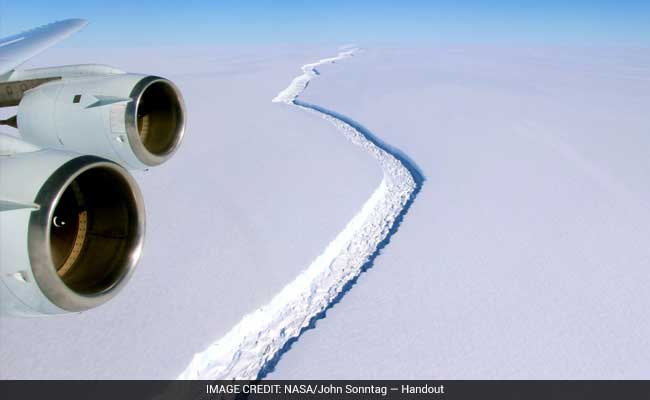Results 1 to 1 of 1
Thread Information
Users Browsing this Thread
There are currently 1 users browsing this thread. (0 members and 1 guests)
-
01-10-2017, 09:24 PM #1
Crack In This Antarctic Ice Shelf Just Grew By 11 Miles. A Break Could Be Imminent
The Crack In This Antarctic Ice Shelf Just Grew By 11 Miles. A Break Could Be Imminent.
World | © 2017 The Washington Post | Chris Mooney, The Washington Post | Updated: January 08, 2017 00:08 IST
The Larsen C rift on the Antarctic peninsula on November 10, 2016.
HIGHLIGHTS
- Scientists say the shelf might lose nearly 2,000 square miles of ice
- Area under question larger than one of the smallest states in US by area
- The 11-mile growth in the rift comes on top of a 13-mile growth last year
In recent years, Greenland's enormous Petermann glacier has lost huge pieces of ice, one four times the size of Manhattan, one two times its size.
What scientists fear is about to happen in Antarctica would make that look tiny.
A growing rift on the floating Larsen C ice shelf on the Antarctic peninsula - a rift that grew dramatically by another 11 miles last month, according to a team of scientists watching it closely - is setting the shelf up for an imminent loss of nearly 2,000 square miles of ice, these scientists say. That's larger than Rhode Island and almost as big as Delaware.
"It is not visible on optical data yet, but the radar data analysis showed a growth of the rift of about 18 km," said Daniela Jansen, a researcher with the Alfred Wegener Institute in Germany who collaborates with the Project MIDAS team, which announced the rift growth.
The 11-mile growth of the rift comes on top of a 13-mile growth that occurred earlier this year, during the polar night in Antarctica.

A crack in the Larsen C ice shelf as photographed on November 10, 2016.
The researchers with the MIDAS Project, a British government-funded collaboration based at Swansea and Aberysthwyth universities in Wales, report that only 12 miles of remaining ice now connect the shelf to the emerging mega-iceberg, perhaps more properly called an ice "island." The rift itself has now grown by some 50 miles since 2011 and has widened to well over 1,000 feet.
The consequences of the break could be dramatic. As the researchers put it:
"When it calves, the Larsen C Ice Shelf will lose more than 10% of its area to leave the ice front at its most retreated position ever recorded; this event will fundamentally change the landscape of the Antarctic Peninsula. We have previously shown that the new configuration will be less stable than it was prior to the rift, and that Larsen C may eventually follow the example of its neighbour Larsen B, which disintegrated in 2002 following a similar rift-induced calving event."
The British Antarctic Survey also released a statement on the growing rift, saying a huge iceberg is "set to calve" from Larsen C.
""Because of the uncertainty surrounding the stability of the Larsen C ice shelf, we chose not to camp on the ice this season," David Vaughn, the survey's director of science, in the statement.
The floating ice shelf is fed by glaciers that sit above sea level on the Antarctic Peninsula. As the shelf loses mass, these glaciers could flow more quickly - which would contribute to rising sea levels. Losses from the ice shelf alone, however dramatic, would not have that effect, as the shelf is already floating on water, just like an ice cube in your glass.
The Larsen C ice shelf is more than 1,000 feet thick. It is the fourth largest ice shelf in Antarctica, although nothing compared with the two largest, the Ross and Ronne-Filchner ice shelves.
NASA, during a flight in November, captured several spectacular photos of the rift. But that was before further extension of the rift last month.
So what happens now? Swansea University's Adrian Luckman, who heads up Project Midas, told the BBC, "If it doesn't go in the next few months, I'll be amazed."
The Alfred Wegner Institute's Jansen largely agreed in a comment to The Washington Post.
"I think the iceberg will calve soon," she said by email. "The jumps of the rift tip occurred in shorter time intervals the longer the rift got. This is probably due to the longer 'lever' for the forces acting to advance the rift, such as the up and down of the tides or strong winds towards the sea. Whether it will be months or maybe next year, I don't know."
So stand by. Things in Antarctica have been getting increasingly, er, interesting for some time, and that shows no sign of stopping.
http://www.ndtv.com/world-news/the-crack-in-this-antarctic-ice-shelf-just-grew-by-11-miles-a-break-could-be-imminent-1646044NO AMNESTY
Don't reward the criminal actions of millions of illegal aliens by giving them citizenship.
Sign in and post comments here.
Please support our fight against illegal immigration by joining ALIPAC's email alerts here https://eepurl.com/cktGTn
Similar Threads
-
Rising air temperatures caused Antarctic ice shelf collapse
By JohnDoe2 in forum Other Topics News and IssuesReplies: 1Last Post: 09-11-2014, 07:51 PM -
Antarctic ice shelf melt 'lowest EVER recorded, global warming is NOT eroding it'
By AirborneSapper7 in forum Other Topics News and IssuesReplies: 2Last Post: 01-05-2014, 09:03 AM -
18-Mile Crack Seen by NASA in Antarctic Glacier
By JohnDoe2 in forum Other Topics News and IssuesReplies: 0Last Post: 02-03-2012, 02:35 PM -
NASA sees giant crack forming in Antarctic glacier
By JohnDoe2 in forum Other Topics News and IssuesReplies: 0Last Post: 11-03-2011, 07:00 PM -
Huge chunk snaps off storied Arctic ice shelf- Break marks l
By AirborneSapper7 in forum Other Topics News and IssuesReplies: 1Last Post: 07-30-2008, 12:48 AM


 LinkBack URL
LinkBack URL About LinkBacks
About LinkBacks




 Reply With Quote
Reply With Quote


"YOU WILL FOOT THE BILL FOR ILLEGAL IMMIGRANTS!" GOVERNOR HOCHUL...
04-23-2024, 05:46 AM in Videos about Illegal Immigration, refugee programs, globalism, & socialism